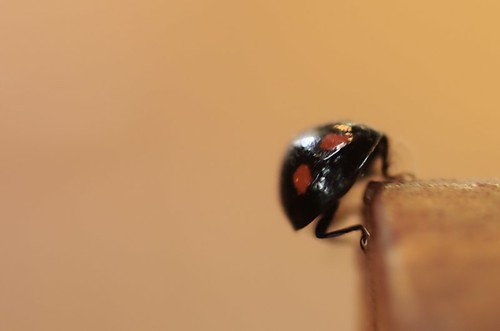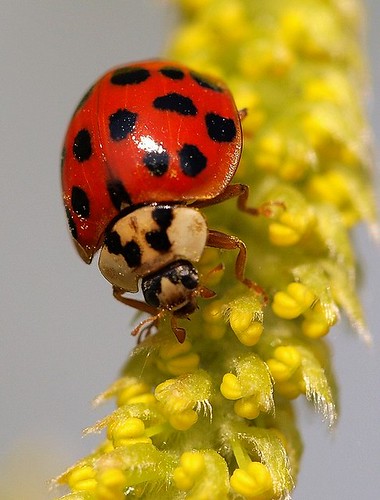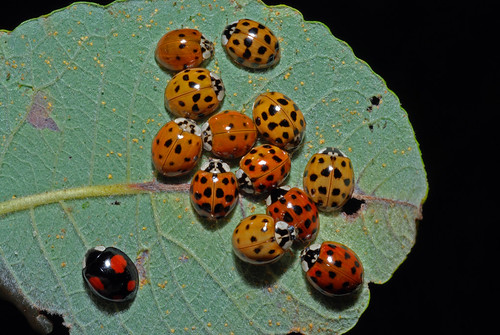
(to english text)
Of de nadelen van biologische bestrijding
Gisteren kwam ik er in huis weer eentje tegen, een veelkleurig Aziatisch lieveheersbeestje (Harmonia axyridis). De laatste jaren zijn het steeds vaker die bonte rakkers, en steeds minder onze inheemse pimpampoentjes (en daarvan zijn er tientallen soorten) die je vindt.
De Aziatische lieveheersbeestjes zijn de laatste jaren vaak ingezet als biologische bestrijders van bladluizen. En niet ten onrechte, want het zijn wellicht de beste bladluizenverdelgers binnen de familie van de lieveheersbeestjes (Coccinellidae). Maar door hun explosieve groei hebben ze op een aantal jaren tijd verschillende van de inheemse soorten zo goed als verdrongen.
Er zijn al observaties die er op wijzen dat de bonte Aziaten zich soms voeden met andere lieveheersbeestjes. Daarnaast worden ze omwille van hun grote aantallen ook door de mens soms als hinderlijk beschouwd: in het najaar gaan ze immers wel eens in zeer grote aantallen op zoek naar onderdak, bijvoorbeeld in huizen. En omdat ze – als ze gestresseerd raken – een slechtruikende vloeistof afscheiden is dat niet altijd even prettig.
En tenslotte blijkt, dat de soort voor de fruitteelt stilaan voor problemen gaat zorgen: Ook in onze boomgaard vinden we regelmatig vruchten waar een aantal van deze lieveheersbeestjes zich als het ware een holletje hebben ingegeten. (Waarschijnlijk gaat het wel om fruit dat door vogels of andere insecten eerder is aangebeten.) Vooral wijnbouwers maken zich zorgen: de beestjes verzamelen zich op de druiventrossen, en zijn er bij het oogsten moeilijk uit te verwijderen, met vervuiling van het resulterende druivensap als gevolg.

In Belgie en Nederland zijn er drie varianten die erg courant gevonden worden, en allemaal zijn ze even groot tot zelfs iets groter dan het best bekende zeven-stippelig lieveheersbeestje:
Harmonia axyrides var. succinea is oranjegeel tot dieprood, met tot maximaal 19 zwarte stippen.
Harmonia axyrides var. spectabilis is zwart, met twee grote rode stippen vooraan, en twee kleinere achteraan.
Harmonia axyrides var. conspicua is ook zwart, met twee rode stippen.
Alle vormen hebben aan de zijkant van hun borststuk witte vlekken die veel groter zijn dan bij de inheemse vormen, en bovendien hebben ze – maar daarvoor moet je al erg goed kijken – een klein deukje in de achterkant van hun achterlijf.
Hoe ga je dan bladluizen bestrijden? Door te zorgen dat de tuin (ook) een vriendelijk oord is voor hun inheemse bestrijders. (Zo zie ik in het voorjaar vaak koolmezen de twijgjes van de haag onder handen (onder snavel?) nemen, en takje voor takje bladluis-vrij poetsen.) En ik realiseer me in de eerste plaats, dat een tuin met veel vogels, ook een tuin is waar het voedsel van die vogels in voldoende mate voorhanden is… en dat ik om de vogel te horen zingen, dus ook de bladluis voor lief moet nemen!
Asian lady beetle – or the cons of biological aphid controle
Yesterday again, I found one in our house, an Asian lady beetle (Harmonia axyridis).
In the last few years, you find more often those Asian ones here, than our native ladybirds (and there are many different species!)
The Asian lady beetles are imported here as a biological aphid control, and for a good reason, since they seem to be the top-aphid eaters within the family of ladybugs (Coccinellidae). But they are multiplying rapidly, and decrease the diversity of native ladybird species, maybe because they also eat other Coccinellidae.
For us, humans, the beetle are only a bit of a nuisance, when in autumn they seek shelter in houses, often in large groups of hundreds of beetles or even more. Sometimes, when under stress, they produce a foul-stinking fluid.
There is also some concern that those beetles are becoming a pest of fruit production. Here in our orchard too, I find sometimes an apple of a pear with a couple of these ladybugs, gathered in a hole in the fruit. But probably that only happens to fruits already blemished by bird’s picking or other insect’s bites.
However, there is greater concern over the beetle becoming a contaminant in vineyards. The difficulty in removing beetles from clusters of grapes may result in the beetles being crushed with grapes during processing and contamination of wine being produced.
It’s difficult to tell how an Asian lady beetle looks like: in Dutch we call them ‘veelkleurig’, multicolored, because there are already more than 200 different variants known of this species.
In our region, but it may be different in yours, these three are the most common:
Harmonia axyrides var. succinea is pale orange to dark red, with zero to 19 black dots.
Harmonia axyrides var. spectabilis is black, and has two large and two smaller red dots.
Harmonia axyrides var. conspicua is black too, and has two red dots.

All variants seem to have white spots on their pronotum that are much larger than in other Coccinellidae species. And they have a small dent on the end of their abdomen, but that’s not so easy to spot.
But how should you control the aphids in the garden then???
Well… Should you? I ‘control’ them by presenting to their predators (birds, hoverflies…) a garden that is not only palatable when aphids are there. Yes, I don’t see aphids frequently, although in spring the great tits are ‘cleaning’ the twigs of the hedge of aphids one by one.
Maybe the best way to control aphids, is to realize that a few aphids on your roses are a small price to pay to hear birds sing….
Alleen hoe komen we weer van die aziaten af.
.-= laatste blogbericht: Niet jarig en wel jarig =-.
Bij mijn oma in de tuin zie ik ze regelmatig. Ik heb het altijd leuke insecten gevonden.
I fully agree with your closing remark, a few aphids are not too high a price to pay for hearing birds sing.
I started growing vegetables on my terrace last year, and, because I didn’t want to use any pesticides, I was concerned about pests like aphids. This year, I’m thinking of growing plants to attract them, to encourage both ladybirds and feathered-birds!
.-= laatste blogbericht: FLOW – For the Love of Water =-.
Hello Anne – do you think your ladybugs are a risk to the native population the way the Harlequin is to us in the UK? Maybe Belgium needs to start doing ladybug surveys the way we are in the UK.
.-= laatste blogbericht: The ladybird survey and the approaching Harlequin Invasion =-.
@Rosie: There is not a survey like in the UK, but lots of people records there observations at ‘Waarnemingen.be‘, lots of people record there observations of all species… and that gives some indication too.
In this post, I used the name ‘Asian lady beetle’ as they are caused in the US, but since then i realized they are called Harlequin ladybirds in the UK.
In Belgium, we call anotherspecies ‘harlekijn’, and Harmonia axyrides is called ‘Aziatisch veelkleurig Lieveheersbeestje’, which could be translated as ‘Asian multicolored ladybird’ in English. But they are the same as the ladybirds in your post.